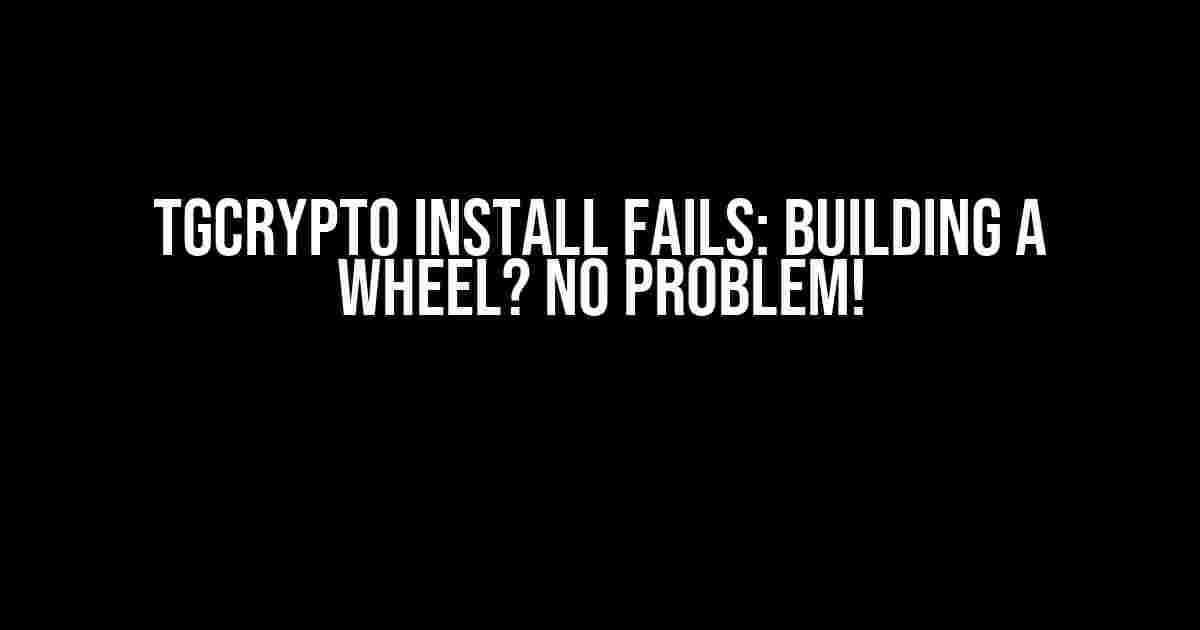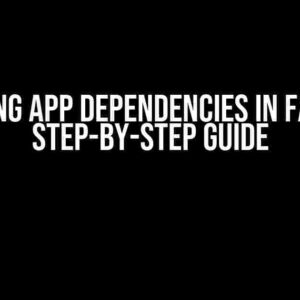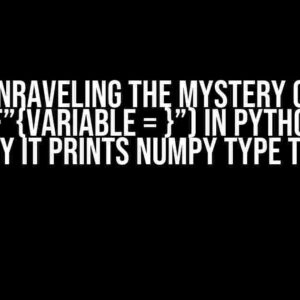Are you tired of encountering the frustrating “tgcrypto install fails building a wheel” error? Do you feel like you’ve tried every solution under the sun, only to end up with the same disappointing result? Fear not, dear reader, for we’re about to embark on a journey to conquer this pesky issue once and for all!
- What’s going on behind the scenes?
- Solution 1: Update pip and Python
- Solution 2: Install required build tools
- Solution 3: Use a compatible operating system and architecture
- Solution 4: Verify Python and pip versions match
- Solution 5: Clear package cache
- Solution 6: Meet dependencies
- Solution 7: Use a different wheel builder
- Conclusion
What’s going on behind the scenes?
Before we dive into the solutions, let’s take a quick peek at what’s happening when you try to install tgcrypto. When you run pip install tgcrypto, pip (Python’s package installer) attempts to build a wheel for your system. A wheel is a pre-built package that contains the necessary files for installation. However, when the wheel build process fails, you’re left with the dreaded error message.
Common Causes of the Error
There are several reasons why the wheel build process might fail. Here are some common culprits:
- Outdated pip or Python versions
- Missing or outdated build tools (e.g., GCC, Make)
- Incompatible operating system or architecture
- Mismatched Python and pip versions
- Corrupted package cache
- dependencies not met (e.g., outdated cryptography library)
Solution 1: Update pip and Python
Let’s start with the basics. Ensure your pip and Python versions are up-to-date:
python -m pip install --upgrade pip python -m pip install --upgrade setuptools
Verify your pip and Python versions using:
pip --version python --version
Solution 2: Install required build tools
Depending on your operating system, you might need to install additional build tools:
Ubuntu/Debian:
sudo apt-get update sudo apt-get install build-essential libssl-dev libffi-dev python3-dev
Red Hat/CentOS/Fedora:
sudo yum install epel-release sudo yum install gcc openssl-devel libffi-devel
MacOS (via Homebrew):
brew install openssl brew install pkg-config
Solution 3: Use a compatible operating system and architecture
If you’re using an incompatible operating system or architecture, consider using a compatible environment, such as:
- Docker containers
- Virtual machines (e.g., VirtualBox)
- Cloud services (e.g., AWS, Google Cloud)
Solution 4: Verify Python and pip versions match
Ensure your Python and pip versions match by checking:
python -m pip --version
If the versions don’t match, reinstall pip using the correct Python version:
python3 -m pip uninstall pip python3 -m ensurepip
Solution 5: Clear package cache
Sometimes, a corrupted package cache can cause issues. Clear the cache using:
pip cache purge
Solution 6: Meet dependencies
Ensure you have the required dependencies installed, such as the cryptography library:
pip install cryptography
Solution 7: Use a different wheel builder
As a last resort, you can try using a different wheel builder, such as:
pip install --only-binary :all: tgcrypto
This command forces pip to use a pre-built wheel, which might resolve the issue.
Conclusion
By following these solutions, you should be able to overcome the “tgcrypto install fails building a wheel” error. Remember to:
- Update pip and Python
- Install required build tools
- Use a compatible operating system and architecture
- Verify Python and pip versions match
- Clear package cache
- Meet dependencies
- Use a different wheel builder (if needed)
With persistence and patience, you’ll be able to successfully install tgcrypto and continue working on your project.
| Solution | Command(s) |
|---|---|
| Update pip and Python | python -m pip install --upgrade pip and python -m pip install --upgrade setuptools |
| Install required build tools | Depends on the operating system (see Solution 2) |
| Use a compatible operating system and architecture | Use a compatible environment (e.g., Docker, VirtualBox, cloud services) |
| Verify Python and pip versions match | python -m pip --version and reinstall pip if necessary |
| Clear package cache | pip cache purge |
| Meet dependencies | pip install cryptography |
| Use a different wheel builder | pip install --only-binary :all: tgcrypto |
Remember, when in doubt, try a combination of these solutions or seek guidance from online forums and communities.
Frequently Asked Question
Are you tired of seeing “tgcrypto install fails building a wheel” errors? Worry not, friend! We’ve got you covered with some FAQs to get you back on track.
Why does “tgcrypto install fails building a wheel” happen in the first place?
This error usually occurs when the package installer, pip, is struggling to compile the tgcrypto package from source code. This might be due to outdated dependencies, incompatible versions, or even a slow internet connection!
How do I update my pip version to avoid the “building a wheel” issue?
Easy peasy! Simply run the command `python -m pip install –upgrade pip` in your terminal or command prompt. This will ensure you have the latest pip version, which might just do the trick to resolve the error.
What if I’m using a virtual environment? Does that change things?
Yes, it does! If you’re working within a virtual environment, make sure to activate it before running the installation command. Also, try reinstalling the package by running `pip install –force-reinstall tgcrypto`. This might help rebuild the wheel and get things working again.
Are there any specific dependencies I should check or update?
Good thinking! Yes, outdated dependencies can cause problems. Make sure you have the latest versions of cython, openssl, and Microsoft Visual C++ Build Tools installed. Additionally, check if you have the correct version of Python installed (tgcrypto supports Python 3.6 and above).
What if none of these solutions work? Where can I go for more help?
Don’t worry, friend! If none of the above solutions work, you can try searching for more specific error messages or browse through GitHub issues related to tgcrypto. You can also post a question on Stack Overflow or Reddit’s r/learnpython community, where helpful folks will be happy to lend a hand.




